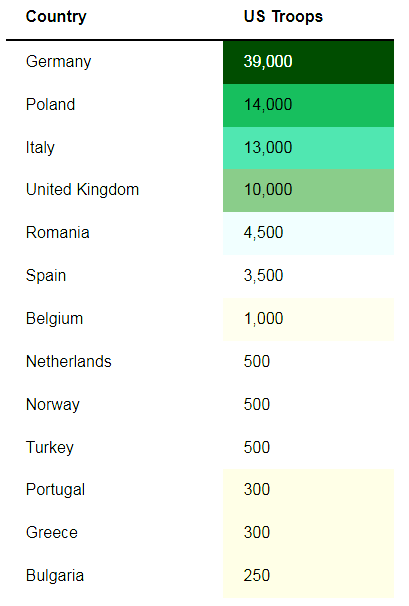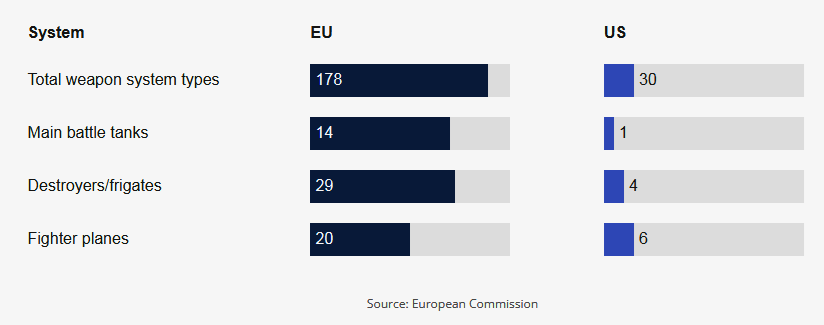
With the United States pivoting its foreign policy focus toward the Indo-Pacific, Europe finds itself at a critical crossroads. The security umbrella once provided by Washington is thinning, and the continent is being called on to step up and assume responsibility for its own defense, writes ‘The Geopolitical Monitor’ from Toronto.
Meanwhile, Russia is no longer hiding behind strategic ambiguity. Moscow is pursuing a foreign policy that is openly ideological and the Russian war economy will continue to pose a material threat to Europe in military terms. This rapidly evolving geopolitical outlook on the continent begs the question: Is Europe prepared to face Russian aggression without US support?
For over 70 years, Europe has relied on the United States to ensure its security. At the height of the Cold War, 470,000 US troops were stationed across the continent. Those days are long gone, though. After the Cold War ended, the Clinton administration cut troop levels to 113,000 by 1997. Under George W. Bush, they fell further to 66,000 in 2008. By 2013, only 63,000 US troops remained forward-stationed in Europe.
As of April 2025, around 84,000 US service members remain stationed on the continent, concentrated mainly in Germany (39,000), Poland (14,000), Italy (13,000), and the UK (10,000). Yet beneath the surface, this fundamental strategic shift continues to play out.

The return of Donald Trump to the White House has reignited deep tensions within NATO. President Trump’s rhetoric is no longer just provocative, it’s policy. His administration has made it clear: Europe can no longer rely on indefinite US protection while failing to meet its defense obligations.
While previous presidents (Eisenhower, Reagan, even Obama) criticized Europe’s burden-sharing problem, Trump is the first to treat it as a breaking point. His approach is unapologetically pragmatic: If Europe doesn’t step up, the US will step away.
In Brussels, US Defense Secretary Pete Hegseth recently delivered a message that echoed across the Atlantic: Washington is recalibrating. The new priority is China, not Europe. The Indo-Pacific, not the North Atlantic. This isn’t posturing: it’s a strategic pivot with long-term implications. To this end, senior Pentagon officials are reportedly mulling plans to withdraw 10,000 troops from Eastern Europe, part of the 20,000-man contingent deployed in 2022.
As the United States pulls back, the burden of Ukraine’s future now falls on Europe’s shoulders. The “coalition of the willing,” led by France and the United Kingdom, signals the beginning of this shift, and Europe must become the guarantor of security on its own continent.
What will this look like? Europe must urgently scale up its defense industrial base, not only to sustain the flow of military aid to Ukraine but also to rearm itself. Doing so rests on a coordinated and long-term and institutionalized strategy, one that goes beyond ad hoc donations or commitments.
Yet Europe’s Achilles heel remains its lack of political cohesion and the absence of a unified strategic culture. This disunity continues to paralyze decision-making at the EU level, especially on security-related matters that still require unanimity. For instance, Hungary’s obstruction, rooted in Prime Minister Viktor Orbán’s longstanding pro-Russian stance and skepticism toward the EU’s involvement in the war, repeatedly exposes the fragility of Europe’s common foreign and security policy. Hungary, together with Slovakia, has consistently undermined EU unity by opposing sanctions on Russia, delaying aid packages, and blocking joint procurement efforts. This behavior not only weakens the credibility of the EU as a geopolitical actor but also emboldens the Kremlin, which continues to exploit internal European divisions. Without unity, resolve, and rapid action, the EU risks permanent consignment to strategic irrelevance.
As Europe navigates this strategic shift, the pressing question remains: is the continent truly prepared to independently secure its borders and counter Russia’s growing military ambitions?
The stark lesson from Ukraine is unmistakable: meeting a 2% GDP defense spending target is insufficient, especially when many European states still struggle to reach even this minimal threshold.
For context, the EU’s total defense spending is projected to reach around 2.04% of GDP in 2025, slightly up from 1.9% in 2024. Yet, this incremental rise pales in comparison to Russia’s accelerated military spending, projected to reach an alarming 6.7% of GDP in 2025.
Yet Europe’s vulnerability is represented by its lack of interoperability and centralized command structure. Without coordination among the 27 EU member states (28 if counting the UK), an effective and cohesive defense strategy remains elusive. Back in 2017, this structural weakness was already evident.
European armed forces operate a fragmented arsenal comprising 178 different types of weapon systems, compared to just 30 in the United States. The contrast is equally significant in air power, with Europe fielding 20 different types of fighter aircraft, while the U.S. relies on only six. This fragmentation is also evident in MBTs: European forces use 14 different models while Washington uses only one.

Yet interoperability cannot be achieved without harmonized procurement. Europe’s defense architecture still resembles a patchwork of 27 armies buying 27 different versions of the same capability. This isn’t just inefficient but also dangerous. Thus, the continent must begin to think in terms of a single, unified defense market, not 27 fragmented national ones.
True strategic autonomy would require a fiscal revolution in European defense spending. An additional €250 billion per year, and national budgets rising to 3.5% of GDP, would be the minimum required to build a credible deterrent force. Ammunition, drones, tanks, and air-defense systems need to be produced at industrial scale. But such a scale is only achievable through pan-European procurement, where joint production lines serve multiple nations with standardized platforms. Only through economies of scale can Europe afford to boost war production, stockpile ammunition, and modernize its industrial base at the pace required by the new security reality.
However, such a shift demands political will. It means surrendering part of national control over defense planning, and trusting in European institutions to coordinate, allocate, and execute effectively. The alternative however is arguably worse: a slow, expensive, and incoherent militarization that fails to deliver the desired military readiness.
read more in our Telegram-channel https://t.me/The_International_Affairs

 10:13 30.04.2025 •
10:13 30.04.2025 •






















